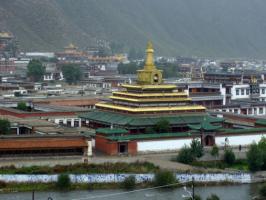Join-in Group Silk Road China Tours
About Us | Contact us | Tourist Map | Hotels | Feedback
Turpan Attractions

Overview:The Bezeklik/Kizil Thousand Buddha Caves is famous for ancient muralsWith with exsiting 60 caves, and over 40 caves have ancient murals of 1200 square meters.
The site is complex of Buddhist cave grottos dating from the 5th to 14th century. The cave groups sit 45 kms away from Turpan city at the north-east of the Taklamakan Desert near the ancient ruins of Gaochang in the Mutou Valley, a gorge in the Flaming Mountains, China. The caves high on the cliffs of the west Mutou Valley under the Flaming Mountains, and most of the surviving caves date from the Uyghur Kara-Khoja kingdom around the 10th to 13th centuries.
The Bezeklik/Kizil Thousand Buddha Caves is famous for ancient muralsWith with exsiting 60 caves, and over 40 caves have ancient murals of 1200 square meters. The site is complex of Buddhist cave grottos dating from the 5th to 14th century. The cave groups sit 45 kms away from Turpan city at the north-east of the Taklamakan Desert near the ancient ruins of Gaochang in the Mutou Valley, a gorge in the Flaming Mountains, China. The caves high on the cliffs of the west Mutou Valley under the Flaming Mountains, and most of the surviving caves date from the Uyghur Kara-Khoja kingdom around the 10th to 13th centuries.
Bezeklik Murals
Pranidhi scene, temple 9 (Cave 20)There are 77 rock-cut caves at the site. Most have rectangular spaces with rounded arch ceilings often divided into four sections, each with a mural of the Buddha. The effect is of entire ceiling covers with hundreds of Buddha murals. Some murals show a large Buddha surrounded by other figures, including Indians, Persians and Europeans. The quality of the murals vary with some being artistically naive while others are masterpieces of religious art.
The murals at Bezeklik have suffered considerable damage. Many of the murals were damaged by local Muslim population whose religion proscribed figurative images of sentient beings, the eyes and mouths in particular were often gouged out. Pieces of murals were also broken off for other uses by the locals. During the late nineteen and early twentieth century, European and Japanese explorers found intact murals buried in sand, and many were removed and dispersed around the world. Some of the best preserved murals were removed by German explorer Albert von Le Coq and sent to Germany. Large pieces such as those showing Pranidhi scene were permanently fixed to walls in Museum of Ethnology in Berlin. During the Second World War they could not be removed for safekeeping, and were thus destroyed when the museum was caught in the bombing of Berlin by the Allies. Other pieces may now be found in various museums around the world, such as the Hermitage Museum in St. Petersburg, Tokyo National Museum in Japan, the British Museum in London, and the national museums of Korea and India.


